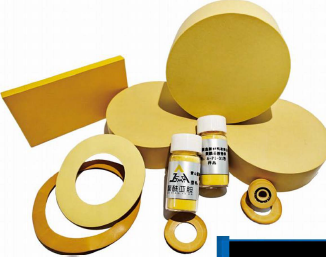A-PI-3S Filled polyimide resin.
A-PI-3S is a filled polyimide resin. The powder particles are uniform, and it disperses really well. Adding just a tiny bit can significantly improve the wear resistance and creep resistance of PTFE products. It can also be used as an adhesive for making grinding wheels.
Handling & Processing Notes
Important guidelines for storage, mixing, and sintering to ensure optimal performance and product quality.
Store it in a dry place. It's a good idea to heat treat it before using it, and make sure the moisture content is below 0.5%.
Use a temperature-controlled mixer and keep the process below 25°C to prevent PTFE clumping. Mix in stages at varying speeds and eliminate static buildup.
A-PI-33 (another variant mentioned in the data table, not the main product focus here) can be sintered without nitrogen, but you'll get some oxidation circles.
A-PI-34 (another variant) must be sintered in a nitrogen environment. If you don't, the finished part will be a darker color.
Performance Data
Key mechanical and physical properties are shown for both thermoforming and cold forming, with competitor comparison where available.
Resin Properties
|
Test Features |
Test Method |
Unit |
Test Conditions |
A-PI-31 |
A-PI-33 |
A-PI-34 |
PTFE |
|---|---|---|---|---|---|---|---|
|
Particle size D50 |
GB/T 19077-2016 |
µm |
23°C |
21 |
11 |
7 |
25 |
|
Bulk density |
GB/T 16913-2008 |
g/cm³ |
23°C |
0.25 |
0.22 |
0.25 |
0.35 |
10% Filled Polyimide Powder in PTFE Composite Performance (PTFE base is M-111)
|
Test Features |
Test Method |
Unit |
Test Conditions |
10%A-PI-31 +90%PTFE |
10%A-PI-33 +90%PTFE |
10%A-PI-34 +90%PTFE |
100%PTFE |
|---|---|---|---|---|---|---|---|
|
Forming density |
GB/T 4472-201 |
g/cm³ |
23°C |
2.05 |
2.04 |
2.05 |
2.15 |
|
Tensile Strength |
GB/T 1040.1-2018 |
MPa |
23°C |
12 |
12 |
13 |
22 |
|
Elongation at break |
GB/T 1040.1-2018 |
% |
23°C |
302 |
305 |
324 |
423 |
|
Friction coefficient |
GB/T 3960-2016 |
/ |
2h |
0.11 |
0.08 |
0.09 |
0.08 |
|
Mass of wear |
GB/T 3960-2016 |
mg |
2h |
1.3 |
1.1 |
1 |
204 (20min) |
The above data are product sample measurement values, not guaranteed values; All products are formed by compression, with a certain degree of directionality.

